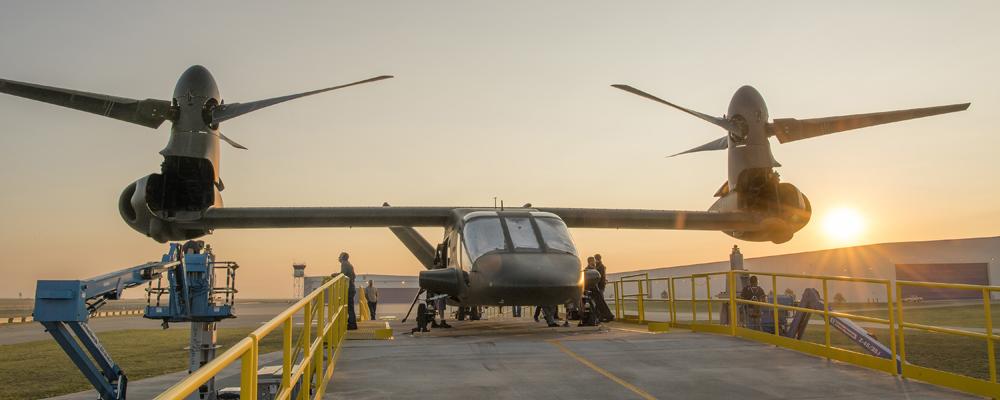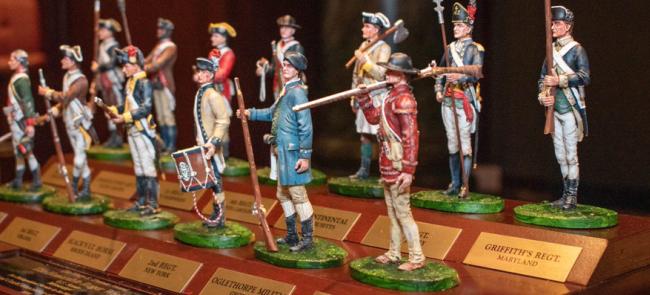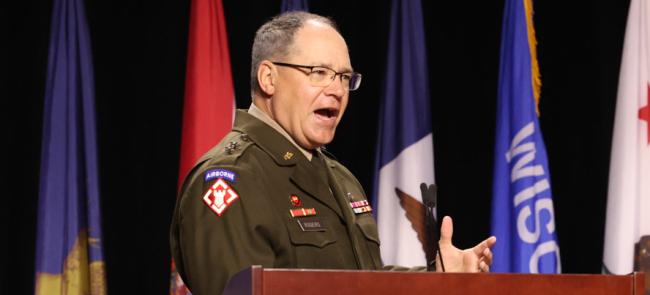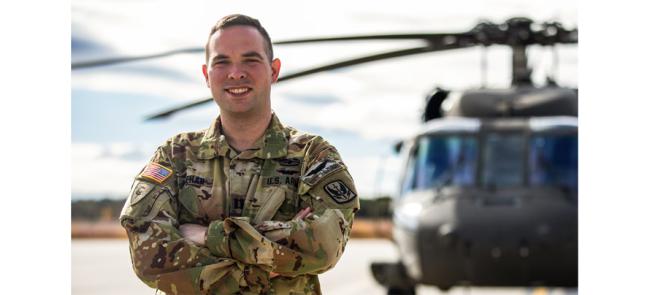
A Focus on Tomorrow
The Army in 2018 stood up a new four-star command in Austin, Texas, to accelerate the development and delivery of warfighting systems needed to overmatch increasing Russian and Chinese capabilities.
And the National Guard is deeply engaged in the effort, says Maj. Gen. John Epperly, who recently took over as deputy commanding general-Army National Guard of Army Futures Command.
“We do not want a tiered Army,” says the Virginia Army Guard officer fresh off of commanding the 29th Infantry Division. “Leadership at the Pentagon level wants to get these capabilities into the National Guard and make sure we are all doing the same thing with the same tools.”
Futures Command touches nearly every aspect of warfighting, from aircraft and artillery to munitions and training. Much of the labor occurs on cross-functional teams that work closely with industry and others outside the Army on specific focus areas, such as long-range precision fires or future vertical lift.
Two of the lesser-known teams figure to have the most impact on Guard troops and units: one looking at networks and the other at positioning, navigation and timing, or PNT.
“Having a robust network and architecture will allow us to reach even those far-flung armories out in the middle of the state,” says Col. Craig Fournier, the deputy director of Acquisition and Systems, Army Futures Command. “That allows for greater speed in the training environment, opening the aperture for synthetic training, virtual training — things that are important to the Guard.”
Even more important is the essential leap in mobility that enhanced networking would provide tactical operations centers on battlefields expected to be more lethal and fluid in the future.
“The network team is responsible for our command-and-control nodes in terms of making them more agile and survivable,” Epperly says. “A division command post has a whole lot of tents, a whole lot of systems. It weighs a lot, it goes in a lot of boxes. We want to tear it down quickly, move it, set it up quickly.”
The work of the PNT team, meanwhile, could bring sweeping changes to the GPS-enabled systems that support everything from aircraft to vehicles to soldiers on the ground.
“The Air Force has been busy launching next-generation GPS satellites that carry military code, a more jam resistant and a more secure satellite uplink and downlink,” Epperly says. “That is the glue that holds everything else together and right now we are at an inflection point, with the services all getting ready to connect to these systems. The Guard will need to play in that in order to have as good a connection as everyone else.”
Futures Command is also supporting the Guard’s ongoing division alignment, which will return much of the force’s combat structure to the eight division headquarters. Brigade combat teams have operated independent of the divisions in recent years while the U.S. military focused on counterinsurgencies.
“We have to have a higher echelon to be effective in fighting against a peer adversary like the Russians or the Chinese,” Epperly says.
In a division-centric model, Fournier says the Guard will compete and recommend which units will eventually get many of the new weapons systems under development. But for that to happen, Futures Command will have to succeed where the Army has seen little success in recent years: developing big ticket weapon systems.
Service officials canceled the Comanche helicopter and Future Combat Systems programs with little to show for the billions of dollars spent. There have also been multiple attempts to field a new armed scout helicopter and a new combat vehicle over the past 15 years.
It was that series of failures that prompted the Army to create the new approach to modernization that is Futures Command.
Leadership at the Pentagon level wants to get these capabilities into the Guard.
—Maj. Gen. John Epperly, the deputy commanding general-Army National Guard of Army Futures Command
THE ARMY’S BIG GUNS have challenges. Army field artillery is outgunned and outranged by Russian weapons. It would also have trouble knocking out entrenched North Korean artillery or mobile Iranian weapons, according to a recent RAND report.
That makes precision fires the Army’s No. 1 modernization priority.
Futures Command’s Long-Range Precision Fires Cross-Functional Team is working on multiple concepts to extend the range of Army field artillery and missile systems. These include the Extended Range Cannon Artillery system, a Precision Strike Missile and a strategic long-range cannon that can deliver rounds more than 1,000 miles.
The Army has already demonstrated progress on ERCA. In March, a modified M109A7 Paladin 155mm self-propelled howitzer fired two rocket-assisted projectiles with a supercharged propellant 65 kilometers (40 miles) and hit their intended targets at Yuma Proving Ground, Arizona.
That’s twice the range of current M109A7s. The Army used the same methodology two years ago to double the reach of the M777 155mm towed light howitzer. Russian heavy artillery has a maximum range of about 37.5 kilometers (23 miles).
“You are never going to talk a division commander who didn’t lament the fact that our adversaries could outrange us and outgun us,” Epperly says. “There have been significant limitations on Army maneuvers because of our range challenges, so we are super excited about long-range precision fires.”
The Army plans to begin fielding the ERCA canon in fiscal 2023. With 57% of the Army’s artillery force structure, the Guard figures to see ERCA sooner rather than later.
“We are focusing on getting the ERCA to a Guard formation fairly early on, while also making the Guard’s artillery more effective,” Epperly says. “It will not only be the cannon but also the munitions, making our existing artillery more effective with better munitions.”
Futures Command is also exploring new aircraft, also referred to as future vertical lift, including replacement for the UH-60 Black Hawk helicopter, the Future Long-Range Assault Aircraft, and a new armed scout, the Future Attack Reconnaissance Aircraft.
The FLRAA has garnered the bulk of the aviation world’s attention thus far. Two very different aircraft are the contenders: Bell’s V-280 Valor tilt-rotor aircraft and the SB-1 Defiant coaxial helicopter built by Sikorsky, a Lockheed Martin company, and Boeing.
Both aircraft deliver the Army’s perceived need for speed to survive on the battlefield against Russia or China, according to the manufacturers. Bell says the V-280, which is a derivative the of V-22 and CV-22 Osprey flown by the Marines and Air Force, has a cruising speed of 280 knots (322 mph) while the Sikorsky-Boeing team says the Defiant, a brand new aircraft, will cruise at 250 knots (288 mph). The Black Hawk has a cruising speed of about 150 knots (178 mph).
The Army would like to kick off the formal competition next year with a request for proposals. Service leaders are aiming for a contract award in fiscal 2022 for the winning team. Final prototypes would be delivered in 2026 with the production and deployment phase in 2028 and first unit receiving the aircraft in 2030.
And “high priority” Guard units will be among the first to get the FLRAA, Gen. James C. McConville, the Army chief of staff a long-time aviator, told the NGAUS conference in Denver last year.
The Army would also like to field the FARA in 2030. It will fill a critical capability gap currently handled by AH-64 Apache attack helicopters teamed with Shadow unmanned aircraft following the retirement of the OH-58D Kiowa Warrior helicopters.
Bell and Sikorsky are locked into a head-to-head competition to produce the aircraft.
“You need competition in the industrial base, and they’re still doing their prototyping and demonstration and development phase,” Fournier says. “That’s kind of the normal thing, but we’re doing it at an accelerated pace. We want to get things in the hands of soldiers earlier so that they can give us feedback faster, so that we know that this does or does not work.”
The new aircraft “will bring the Guard on par with active component,” he adds. “Obviously the mission would change if you’re talking about domestic use of an aviation platform, I don’t expect to see FARA used in the states other than for surveillance. But the FLRAA would bring that lift, and the adjutants general of the states are interested in how much lift they’re going to be apportioned in the future.”
The Guard, and the rest of the Army, isn’t sitting still as it awaits these new capabilities. Epperly pointed to the recent Project Convergence exercise, which aimed to rapidly merge the service’s capabilities with joint assets in the air, land, sea, space and cyber domains.
The project has looked specifically at so-called air-launched effects — small unmanned aerial vehicles carried aboard and released from larger aircraft, such as Black Hawk or Apache, to provide extended reach. “How do we queue fires from an unmanned system? How do we do this manned-unmanned teaming? This is going to be really important from a survivability and lethality perspective,” he says.
Air-launched effects “are a lot less expensive, so we can get those into the Guard quickly to leverage our existing airframes more effectively without a major investment, while we wait to get FARA and FLRAA into the Guard inventory,” Epperly says.
We want to get things in the hands of soldiers earlier so that they can give us feedback faster, so that we know that this does or does not work.
—Col. Craig Fournier, the deputy director of Acquisition and Systems, Army Futures Command
THE GUARD HAS BEEN DEEPLY INVOLVED in Futures Command, helping to shape the design of future systems and working to ensure that when these systems become availability, the Guard will have equipment parity, Fournier says.
“All of the states have a readiness advisory council. The TAGS are involved, they have subcommittees,” he says. “We take all of that information and it gets piped into Futures Command. The Army’s [overall] doctrine, organization, training, materiel, leadership and education, personnel, facilities and policy [strategy] further ensures integration of the Guard interest throughout the [Futures Command] structure.
The Guard helps drive the day-to-day work of the command, Epperly says.
“We have Guardsmen in every CFT out there, we have Guardsmen in every element of Army Futures Command headquarters in Austin,” he explains. “We have a seat at the table and there’s depth and breadth. We are making contributions every single day.”
“We are always talking about how we can use the Guard and all our wonderful talent to support the CFTs,” he said. “We have Guardsmen with great expertise and I am working with Futures Command management to utilize those people to help drive the Futures Command mission. The Guard and Reserve can assist with talent in a wide range of areas, so we don’t just have a seat at a table, we are a major contributor in terms of the talent we bring to the fight.”
All of this helps to ensure that the Guard will have early access to emerging capabilities. Of course, much depends on funding, and Guard officials are pressing forward on that front as well. Epperly suggests the Guard’s deep and ongoing relationships with lawmakers can help to ensure a budget stream that would enable rapid adoption of Futures Command innovations.
“The Guard really connects America’s Army to America, we create that linkage that in turn connects us to our elected officials,” he says. “We can help to improve their knowledge. They can work with units in their home states and have an opportunity to connect with the Army in a way that they otherwise couldn’t do.
“By keeping Congress educated on the needs of the Army, the Guard becomes a strong voice, and when their knowledge comes from their encounters with the Guard, that puts us in a very strong position.”
Adam Stone is an Annapolis, Maryland-based freelancer. He can be reached via [email protected].



